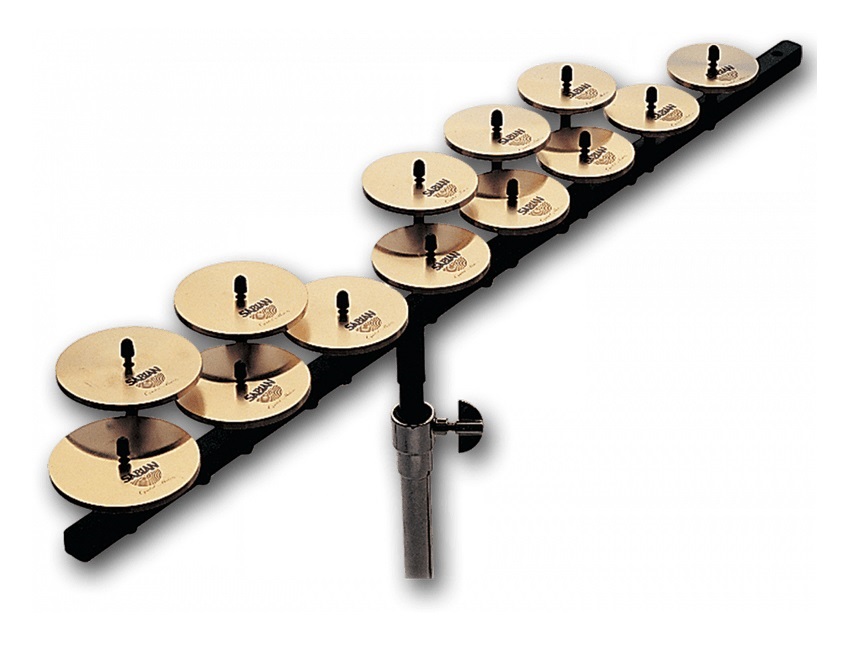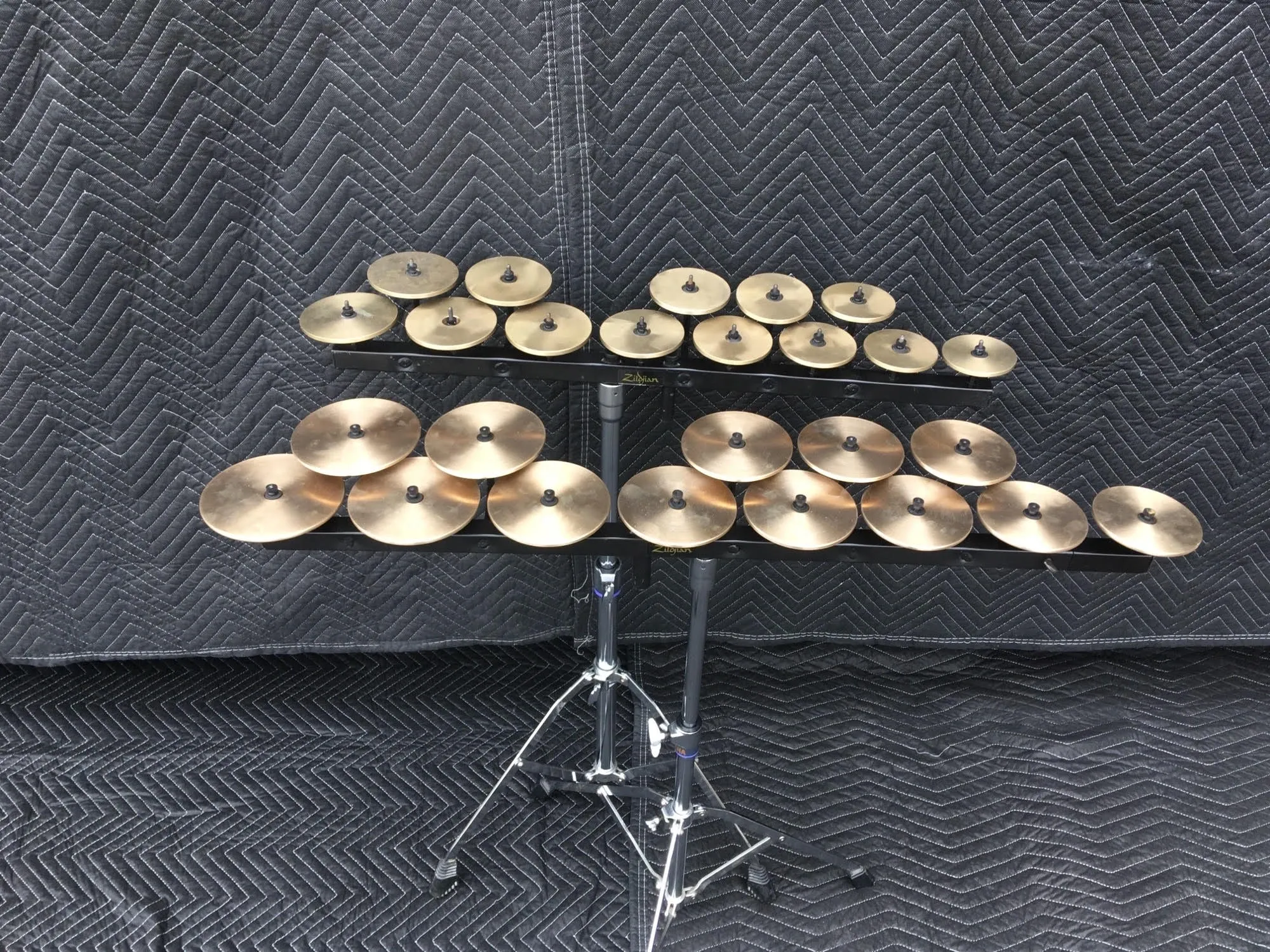Crotales
Melodic Percussions
Europe
Between 0 and 1000 AD
Video
Crotales are a percussion instrument consisting of small, tuned metal discs arranged in a chromatic scale. Each disc, or cymbal, is made of a thick bronze alloy and produces a bright, bell-like sound when struck. They are typically arranged in two octaves, although some sets may extend beyond this range. Crotales resemble small cymbals but are played more like a glockenspiel or keyboard percussion instrument.
The instrument can be played using a variety of techniques. Musicians typically use hard mallets, which bring out the instrument’s sharp, clear tones. Soft mallets can be used for a more subdued sound. Additionally, players sometimes bow the edge of a crotale with a double bass bow to produce an eerie, sustained ringing sound.
Types and Features
There are generally two main types of crotales: standard orchestral crotales and antique cymbals. Standard crotales are designed for professional orchestral and ensemble use, typically mounted on a stand or keyboard-like rack. They follow a precise tuning system and are played with mallets. Antique cymbals, often confused with crotales, are a historical variant with a looser tuning system and may not be arranged chromatically.
One of the most distinguishing features of crotales is their high-pitched, penetrating sound. Due to their relatively small size, they are compact and easily transportable, making them an efficient addition to orchestras, percussion ensembles, and contemporary music settings. Their shimmering, ethereal quality allows them to cut through dense musical textures, making them useful for creating distinct tonal accents and colorations.
History and Origin
Crotales have a long and varied history, with their origins tracing back to ancient civilizations. Though the modern instrument is a product of orchestral refinement, its roots extend to ancient cultures where small metal cymbals and tuned percussion instruments were used for religious, ceremonial, and musical purposes.
The earliest known predecessors of crotales can be traced to Ancient Egypt, Greece, and Rome, dating back to at least the first millennium BCE. In Ancient Greece, instruments similar to crotales, known as “kymbala,” were used in religious ceremonies and festivals. These early forms of crotales were typically small bronze cymbals, played either by striking them together or with sticks.
During the medieval and Renaissance periods, small tuned cymbals were occasionally used in religious music and folk traditions. However, it was in the 19th and 20th centuries that the modern crotales, as seen in orchestral and contemporary music, were fully developed. The French composer Claude Debussy was among the first to employ crotales in an orchestral setting, notably in his piece “Prélude à l’après-midi d’un faune.”
Work Mechanics of Crotales
The mechanics of crotales rely on the properties of resonance and vibration. When struck with a mallet, each disc vibrates at a specific frequency corresponding to its pitch. The metal’s density and shape ensure a sustained, pure tone with minimal overtone interference. The discs are typically suspended on a rack to allow for free vibration, ensuring maximum resonance.
The playing technique is an essential part of how crotales function. The most common method involves striking the discs with hard mallets, producing an immediate and piercing sound. Players can also use softer mallets to create a more mellow effect. Bowing the edge of the crotale with a violin or bass bow creates a long, sustained tone that sounds almost electronic in nature, adding an eerie, ethereal effect to the music.
Role in Music
Crotales serve as a unique addition to orchestral, contemporary, and experimental music. Their distinct sound allows them to be used in various musical contexts, including classical, film scores, and electronic compositions.
In orchestras, crotales are used sparingly but effectively, often playing in high-pitched, shimmering passages to create a celestial or mystical effect. They frequently appear in contemporary classical compositions by composers such as Olivier Messiaen and Pierre Boulez, who explored their unique timbral possibilities. In film and television music, crotales contribute to magical, mysterious, or otherworldly atmospheres, commonly appearing in fantasy and science fiction scores.
In modern percussion ensembles, crotales are often featured as a solo instrument, sometimes played with amplification to enhance their presence. In jazz and experimental music, their unusual tone makes them an attractive choice for composers seeking novel sounds. They have also been incorporated into rock and pop music, sometimes used in live performances for additional tonal variety.
Significance of Crotales
The importance of crotales in music extends beyond their tonal qualities. They add a distinctive sound palette to compositions and allow for creative expression in orchestration and sound design.
One of the key reasons for their significance is their ability to produce pure, sustained tones that cut through dense textures. This makes them particularly effective for accentuating specific moments in compositions, whether in orchestral music, film scores, or avant-garde performances. Crotales also have historical and cultural significance. Their origins in ancient civilizations connect them to a long tradition of metal percussion instruments, demonstrating their enduring musical value. Their use in religious and ceremonial contexts throughout history further underscores their importance beyond purely musical applications.
As a modern instrument, crotales continue to evolve, with contemporary composers finding new and innovative ways to integrate them into various musical genres. Their role in electronic music, where their sounds are often sampled and manipulated, expands their presence in digital music production.
FAQ
What are the primary materials used to make crotales?
Crotales are primarily made from bronze or brass, though variations can include materials like aluminum or wood.
From which continent did the modern concept of crotales originate?
The modern concept of crotales has European origins, though the term "crotalon" has roots in ancient Greece and Rome.
In what musical genres are crotales commonly used?
Crotales are commonly used in classical, contemporary, and world music genres, as well as in some popular music styles.
 Links
Links
References
Other Instrument
Categories



















